Ancient treasures destroyed by IS revived in Rome
The full-scale reproductions of the winged human-headed bull from Nimrud in Iraq, part of the state archives hall from the ancient Syrian kingdom of Ebla, and half the roof of the Temple of Bel in Palmyra will be on display until December 11.
"For several years we have been discussing the importance of Italy, and the world, taking action to protect the cultural heritage of war zones, and this exhibition bears extraordinary witness to this endeavour," Italian Foreign Minister Paolo Gentiloni said at the opening.
Syrian archaeological authorities also arranged for two Palmyra statues damaged by IS to be brought to Rome.
Such an emergency "corridor for cultural goods... has never happened during wartime before," said Francesco Rutelli, head of "Incontro di Civilta" [Meetings of Civilisations], the organisation behind the exhibition.
After the exhibition, the two sculptures will be restored in Italy then sent back to Syria.
The three archaeological treasures were recreated with the help of 3D printers, demonstrating that such work could potentially be carried out in situ in future.
It took almost three months to recreate the segment of the Bel temple, according to architect Matteo Fabbri of TryeCo, the Italian company that carried out the work.
"Usually with a 3D scanner we work much more quickly but in this case we had to work from old photographs and verbal descriptions," he told AFP.
"Once we made the model, it was relatively easy. We built the roof with a special resin then "aged" it by hand. This part took a month, said Fabri.
IS has turned their sights on the priceless vestiges of Iraqi and Syrian cultural heritage, which they deem to be "un-Islamic" or the fair casualties of war.
More than 900 monuments or archaeological sites have been looted, damaged or destroyed by the regime, rebels or militants in Syria, where a devastating war has raged since 2011.
IS has carried out a campaign of "cultural cleansing", razing part of ancient Mesopotamia's relics and looting others to sell valued artefacts on the black market to oil its brutal war machine.
In a video released by IS on 26 February 2015, militants were shown using sledgehammers to smash pre-Islamic treasures in the museum in the country's second city Mosul, sparking global outrage.


